We're sorry. An error has occurred
Please cancel or retry.
The use of bacteria in integrated weed management
Regular price
£25.00
Sale price
£25.00
Regular price
£25.00
Unit price
/
per
Sale
Sold out
Re-stocking soon
Annual grass weeds are increasing as a dominant weed species in the western United States, Canada and Mexico. Downy brome, one of the most widespread, invasive annual grass weeds, negatively affect...
Read More

Some error occured while loading the Quick View. Please close the Quick View and try reloading the page.
Couldn't load pickup availability
- Format:
-
26 December 2017

Annual grass weeds are increasing as a dominant weed species in the western United States, Canada and Mexico. Downy brome, one of the most widespread, invasive annual grass weeds, negatively affects cereal yields, reduces forage quality in grazing lands, degrades rangelands, and increases the fire frequency of western lands. This chapter reviews how naturally-occurring bacteria were screened to find those that suppress downy brome but do not harm native plants and crops, and how one such bacterial strain, Pseudomonas fluorescens strain ACK55, was identified as able to a reduce downy brome root formation, root growth, and tiller initiation. It then discusses long-term field trials in the western US, in which application of the bacteria resulted in almost complete suppression of downy brome for three to five years after one application, when desirable plants were present.

Price: £25.00
Publisher: Burleigh Dodds Science Publishing
Imprint: Burleigh Dodds Science Publishing
Series: Burleigh Dodds Series in Agricultural Science
Publication Date:
26 December 2017
ISBN: 9781838794415
Format: eBook
BISACs:
TECHNOLOGY & ENGINEERING / Agriculture / Sustainable Agriculture, Pest control / plant diseases, TECHNOLOGY & ENGINEERING / Agriculture / Agronomy / Crop Science, TECHNOLOGY & ENGINEERING / Pest Control, Sustainable agriculture, Agronomy and crop production

1 Introduction 2 The case of downy brome (cheatgrass, Bromus tectorum L.) 3 Finding a biocontrol agent to manage downy brome 4 Application and results 5 Summary 6 Future trends in research 7 Where to look for further information 8 References



